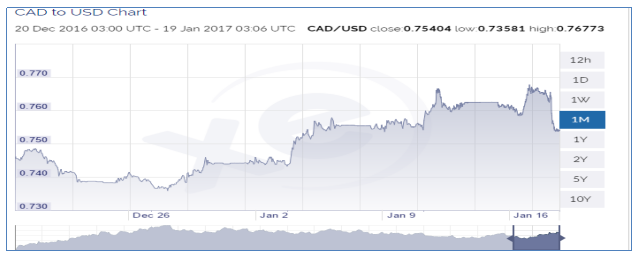The Canadian Dollar started the year at a high note amid signs that the Canadian economy might be poised for growth in 2017. Rallying upwards by about 3% since the beginning of the year, this marks the best annual start since the currency was floated in 1970. The last time the Canadian dollar experienced such gains within the first two weeks of the year was in 2003 when it rose 2.4%. However, according to the analysis of global daily financial news at the Stern Options YouTube channel, the US dollar is expected to strengthen if the Fed raises its interest rates; and hence pull back the gains made by the its Canadian counterpart later on in the year.
On Tuesday 17th January 2017, the Canadian dollar surged up by a whole 1% to an almost three months high of 76.66 US cents. This came in the wake of comments by the President elect Donald Trump that the US dollar was too strong and that its strength was “killing us” – while referring to the US economy. His sentiments put pressure on the US stocks which dropped from their record highs, while the US dollar index experienced a 0.78% drop the same day.
Following Trumps election in November 2016, the greenback has been upbeat jumping to a 13-year high; hence triggering the statement from the President elect that the currency had strengthened so much such that it had resulted to unfair competition for American companies against their Chinese counterparts in the global markets. In his statement, Trump blamed Beijing for holding down the value of the yuan in order to benefit Chinese exporters.
Positive outlook for Canadian dollar with a pullback from the US dollar
According to forecasts compiled by Bloomberg, analysts expect the Canadian dollar to retreat to 73.52 US cents by the end of 2017. The current upward trajectory by the loonie is therefore in the opposite direction from the expected trend.
Initially, the Canadian Imperial Bank of Commerce had predicted that the Canadian dollar would slip to 72.99 US cents, but after analyzing the short-term trend within the first few weeks of 2017 and factoring in the expected economic growth, the bank is reconsidering its predictions.
“We’re in the trade still, but if C$1.30 (76.92 cents) goes we may close it out,” said Bipan Rai, a Toronto-based senior foreign-exchange and macro strategist at the bank. Attributing the recent gains in the Canadian dollar to the optimism on global manufacturing; Rai however said that those improvements were not strong enough to change his mind yet. He believes that there are other macro-economic factors that have not yet been priced in currently including the concern on the expected Trump economic policy changes that could impact the North American Free Trade Agreement (NAFTA) negatively.
Free Reports:
 Get Our Free Metatrader 4 Indicators - Put Our Free MetaTrader 4 Custom Indicators on your charts when you join our Weekly Newsletter
Get Our Free Metatrader 4 Indicators - Put Our Free MetaTrader 4 Custom Indicators on your charts when you join our Weekly Newsletter
 Get our Weekly Commitment of Traders Reports - See where the biggest traders (Hedge Funds and Commercial Hedgers) are positioned in the futures markets on a weekly basis.
Get our Weekly Commitment of Traders Reports - See where the biggest traders (Hedge Funds and Commercial Hedgers) are positioned in the futures markets on a weekly basis.
Not all Trump policies will hurt the Canadian dollar though. Trump has signaled that he may approve the Keystone XL oil pipeline from Alberta’s oil sands to the US Gulf Coast. In addition, he is has promised to authorize new high spending, deregulate the markets and cut taxes; changes whose combined effect could boost Canadian exports of raw materials and equipment to the US. This could in the end support the Canadian dollar from falling drastically against its US counterpart in the long run.
Positive economic growth in Canada is also boosting the loonie.
According to data released on 6th January 2017, Canada posted its first trade surplus in more than two years in November 2016. In addition, 53,700 jobs were created in December of 2016 against the prediction by analysts that the employment numbers would experience a slight decline.
The likelihood of the Bank of Canada raising its interest rate in 2017 has been predicted to be positive by only 30% of analysts. This therefore means that the monetary policy in Canada is going to be rather stable and predictable. On the other hand, the US is expected to raise its interest rates sometime in 2017, hence strengthening the greenback which in turn will weaken the Canadian dollar.
The Trump effect is another pull back on the Canadian dollar, according to Mark McCormick, North American head of foreign-exchange strategy at Toronto-Dominion Bank. McCormick explained that, “The market has been pricing in mostly the good stuff from Trump and largely ignoring the negatives.” He continued to add that, “Trump’s policies will be more inflationary than growth-supportive and Canada continues to lag the U.S. on the closure of the output gap, leading to a wider rate gap and stronger U.S. dollar.”
Viewed collectively the above factors determining the direction the Canadian dollar will take in 2017 seem to imply that all economic fundamentals are supporting a strong Canadian dollar. However, the strength of the US dollar and the economic policy approach by Trump’s administration will weigh in heavily in finally determining the final range within which the loonie will be trading in 2017.
By Taylor Wilman
